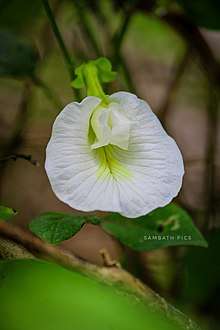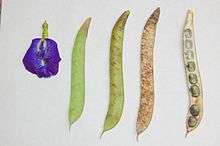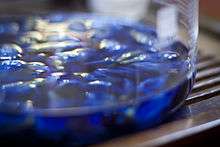Clitoria ternatea
Clitoria ternatea, commonly known as Asian pigeonwings,[1] bluebellvine, blue pea, butterfly pea, cordofan pea and Darwin pea,[2] is a plant species belonging to the family Fabaceae.
| Clitoria ternatea | |
|---|---|
.jpg) | |
| Flowers and foliage | |
| Scientific classification | |
| Kingdom: | |
| Division: | |
| (unranked): | |
| (unranked): | |
| Order: | |
| Family: | |
| Genus: | |
| Species: | C. ternatea |
| Binomial name | |
| Clitoria ternatea | |

In India, it is revered as a holy flower, used in daily puja rituals. The flowers of this vine were imagined to have the shape of human female genitals, hence the Latin name of the genus "Clitoria", from "clitoris".
Distribution
This plant is native to equatorial Asia, including locations the Indian sub-continent and Southeast Asia but has also been introduced to Africa, Australia and America.
Description

It is a perennial herbaceous plant, with elliptic, obtuse leaves. It grows as a vine or creeper, doing well in moist, neutral soil. The most striking feature about this plant is the color of its flowers, a vivid deep blue; solitary, with light yellow markings. They are about 4 cm (1.6 in) long by 3 cm (1.2 in) wide. Some varieties yield white flowers.
The fruits are 5–7 cm (2.0–2.8 in) long, flat pods with six to ten seeds in each pod. They are edible when tender.
It is grown as an ornamental plant and as a revegetation species (e.g., in coal mines in Australia), requiring little care when cultivated. As a legume, its roots form a symbiotic association with soil bacteria known as rhizobia, which transform atmospheric N2 into a plant-usable form (a process called nitrogen fixing), therefore, this plant is also used to improve soil quality through the decomposition of nitrogen rich plant material.
.jpg)
Uses
Food
In Southeast Asia, the flower is used as a natural food colouring to colour glutinous rice. In Kelantan, in the north-east of peninsular Malaysia, it is an important ingredient in nasi kerabu, giving it its characteristic bluish colour. In Burmese and Thai cuisines, the flowers are also dipped in batter and fried.
Butterfly pea flower tea is made from the ternatea flowers and dried lemongrass and changes color depending on what is added to the liquid, with lemon juice turning it purple.[3] In Thailand and Vietnam, this butterfly blue pea flower tea is commonly mixed with honey and lemon to increase acidity and turn the beverage a pink-purple color, to produce for a drink usually served after dinner, or as a refreshment at hotels and spas.[4] The drink is a typical local drink like chamomile tea is in other parts of the world.[4] The tea is found in both hot and cold varieties [5]
The flowers have more recently been used in a color-changing gin. Blue in the bottle, it turns pink when mixed with a carbonated mixer such as tonic water due to the change in pH.[6] As organic colours are not permanent, this type of gin is recommended to be stored in a dark place to maintain the effect.[7]
Traditional medicine
In traditional Ayurvedic medicine, it is ascribed various qualities including memory enhancing, nootropic, antistress, anxiolytic, antidepressant, anticonvulsant, tranquilizing, and sedative properties.[8] In traditional Chinese medicine, the plant has been ascribed properties affecting female libido due to its similar appearance to the female reproductive organ.[9]
Chemical constituents
Chemical compounds isolated from C. ternatea include various triterpenoids, flavonol glycosides, anthocyanins and steroids.[8] Cyclic peptides known as cliotides have been isolated from the heat-stable fraction of C. ternatea extract.[10] The blue colour of C. ternatea is a result of various anthocyanins, most importantly ternatins - polyacylated derivatives of delphinidin 3,3', 5'-triglucoside (Da-T).[11][12][13]
Gallery
 Aparajita flower in a Garden from Khandaghosh - west Bengal India
Aparajita flower in a Garden from Khandaghosh - west Bengal India Clitoria ternatea in a Garden from Maracay - Venezuela
Clitoria ternatea in a Garden from Maracay - Venezuela C. ternatea, Isla Margarita, Venezuela
C. ternatea, Isla Margarita, Venezuela Clitoria tea in a pot
Clitoria tea in a pot- Thai khao tom sweet colored blue with C. ternatea flowers
- A less common "double-flowered" C. ternatea
References
- "Clitoria ternatea". Natural Resources Conservation Service PLANTS Database. USDA. Retrieved 31 Jul 2016.
- "Clitoria ternatea L." Germplasm Resources Information Network (GRIN). Agricultural Research Service (ARS), United States Department of Agriculture (USDA). Retrieved 31 Jul 2016.
- Pantazi, Chloe (February 26, 2016). "Watch this tea dramatically change from deep blue to vibrant red with a squeeze of lemon". Business Insider Deutschland. Retrieved July 2, 2016.
- Goldberg, Elyssa (January 31, 2016). "The Science Behind This Mesmerizing Color-Changing Tea". Bon Appétit. Retrieved July 2, 2016.
- Reid, Marian (October 16, 2012). "Be good to yourself in Chiang Mai". BBC Travel. the British Broadcasting Corporation. Retrieved July 3, 2016.
- "This magical gin changes colour when tonic's added to it". Good Housekeeping.
- "Road test: Ink gin changes colour when mixed with tonic". The Australian. Retrieved 2018-12-18.
- Mukherjee PK, Kumar V, Kumar NS, Heinrich M (2008). "The Ayurvedic medicine Clitoria ternatea-From traditional use to scientific assessment". J Ethnopharmacol. 120 (3): 291–301. doi:10.1016/j.jep.2008.09.009. PMID 18926895.
- Fantz, Paul R. (1991). "Ethnobotany of Clitoria (Leguminosae)". Economic Botany. New York Botanical Garden Press. 45 (4): 511–20. doi:10.1007/BF02930715. JSTOR 4255394.
- Nguyen, GK; Zhang, S; Nguyen, NT; Nguyen, PQ; Chiu, MS; Hardjojo, A; Tam, JP. (Jul 2011). "Discovery and characterization of novel cyclotides originated from chimeric precursors consisting of albumin-1 chain a and cyclotide domains in the Fabaceae family" (PDF). J Biol Chem. 286 (27): 24275–87. doi:10.1074/jbc.m111.229922. PMC 3129208. PMID 21596752.
- Terahara, Norihiko; Saito, Norio; Honda, Toshio; Toki, Kenjiro; Osajima, Yutaka (1990-01-01). "Acylated anthocyanins of Clitoria ternatea flowers and their acyl moieties". Phytochemistry. 29 (3): 949–953. doi:10.1016/0031-9422(90)80053-J. ISSN 0031-9422.
- Terahara, Norihiko; Oda, Masahiro; Matsui, Toshiro; Osajima, Yutaka; Saito, Norio; Toki, Kenjiro; Honda, Toshio (1996-01-01). "Five New Anthocyanins, Ternatins A3, B4, B3, B2, and D2, from Clitoria ternatea Flowers". Journal of Natural Products. 59 (2): 139–144. doi:10.1021/np960050a. ISSN 0163-3864.
- Terahara, Norihiko; Saito, Norio; Honda, Toshio; Toki, Kenjiro; Osajima, Yutaka (1990-01-01). "Structure of ternatin A1, the largest ternatin in the major blue anthocyanins from clitoria ternatea flowers". Tetrahedron Letters. 31 (20): 2921–2924. doi:10.1016/0040-4039(90)80185-O. ISSN 0040-4039.
External links
| Wikimedia Commons has media related to Clitoria ternatea. |
- "Plant of the Week—Clitoria ternatea". Archived from the original on 2007-08-09. Retrieved 2007-07-31.
- "Clitoria ternatea". Tropical Forages. Archived from the original on 2007-08-17. Retrieved 2007-07-31.
- A strain of Clitoria ternatea from the Philippines from the Int'l Soc. for Taxonomic Explorations by Isidro A. T. Savillo.